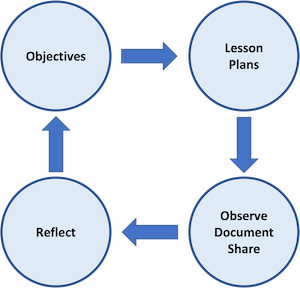.png)
"The brain wont learn unless it feel secure." Dr. Katie Penry
That is right! No child can focus on learning if his or her mind is going circles and thinking 'what happens next?', 'where are we going now?' and so on... Here is a simple tip to calm things down and to help you with planning. It is helpful, effective, and convenient for everyone. Set routines and schedules in early childhood education. It has benefits for teachers, children, and parents too! Keep on reading.
Why love routines?
Teachers love routines. Consistent routines reduce planning time and general commotion in the kindergarten or preschool. The teacher feels that the situation is in control and he/she knows what happens next / tomorrow.
Children love routines. Consistent routines make children feel more safe, calm, and productive. Children feel excited and motivated when they know what is going to happen in the kindergarten.
Parents love routines. Consistent routines decrease stress levels, help with organizing the practical issues and give peace of mind.
So plan each day and each week at the early childhood education based on the same routine. Follow further to see concrete examples.
A digital tool like Kindiedays help you stay organized
How to make a daily schedule?
The kindergarten's or preschool's daily schedule is very important. It lays the foundation for each day! When the basic structure is well planned, the children feel happier, more relaxed, and confident of knowing what will happen next.
You have to take several issues into account when planning the daily schedule:
- What time does the kindergarten/preschool open?
- What time is breakfast/lunch/snack time?
- Is there nap time for the little ones?
- What time does the kindergarten close?
When these basic blocks and times are clear to you, it is pretty easy to build the structure of the daily schedule. Customize the schedule according to your routines.
Here is an example of a daily schedule according to a Finnish kindergarten:
Daily schedule
7:00 Good morning and welcome! Kindergarten opens
7:30-8:30 Breakfast
8:30-10:00 Outdoor playtime
10:15-10:30 Circle time
10:30-11:00 Playtime and activity time
11:15-12:00 Lunchtime
12:00-14:00 Nap time / Storytime and Free play
14:30 Snack time
15:00-17:00 Outdoor playtime
17:00 Bye-bye, see you! Kindergarten closes
Make a visible timetable on the wall, so that the teachers and parents, can see it. After the schedule is visible, everyone knows what happens and when. Nobody needs to fuss. The daily schedule is helpful for the parents as they try to understand their child's day. The same is true for any new staff member.
.png)

.png)

.png)
